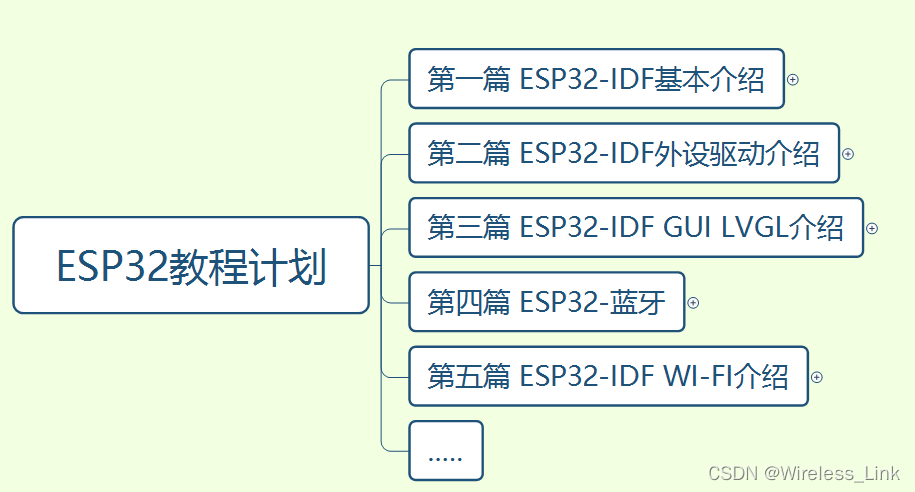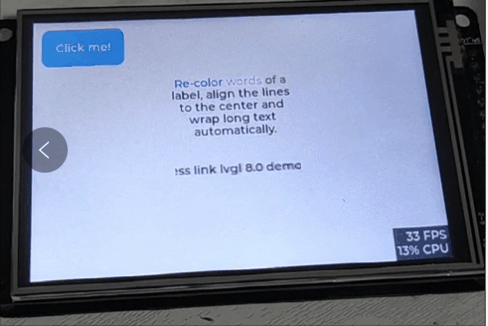?零. 声明
本专栏文章我们会以连载的方式持续更新,本专栏计划更新内容如下:

第一篇:ESP-IDF基本介绍,主要会涉及模组,芯片,开发板的介绍,环境搭建,程序编译下载,启动流程等一些基本的操作,让你对ESP-IDF开发有一个总体的认识,比我们后续学习打下基础!
第二篇:ESP32-IDF外设驱动介绍,主要会根据esp-idf现有的driver,提供各个外设的驱动,比如LED,OLED,SPI LCD,TOUCH,红外,Codec ic等等,在这一篇中,我们不仅仅来做外设驱动,还会对常用的外设总线做一个介绍,让大家知其然又知其所以然!
第三篇:目前比较火热的GUI LVGL介绍,主要会设计LVGL7.1,LVGL8的移植介绍,并且也会介绍各个组件,知道原理后,最后,我们会推出一款组态软件来构建我们的GUI,来提升我们的效率!
第四篇:ESP32-蓝牙,熟悉我的,应该都知道,我即使从事蓝牙协议栈的开发的,所以这个是我们独有的优势,在这一篇章,我们会提供不仅仅是蓝牙应用方法的知识,也会应用结合蓝牙底层协议栈的理论,让你彻底从上到下打通蓝牙任督二脉!
第五篇:Wi-Fi介绍,熟悉我的,应该也知道,我们也做过一款sdio wifi的驱动教程板子,所以在wifi这方面我们也是有独有的优势,在这一篇章,我们同样不仅仅提供Wi-Fi应用方面的知识,也会结合底层理论,让你对Wi-Fi有一个清晰的认知!
另外,我们的教程包括但是不局限于以上篇章,为了给你一个更好的导航,以下信息尤其重要,请详细查看!!
------------------------------------------------------------------------------------------------------------------------------------------
蓝牙交流扣扣群:539357317
微信公众号↓↓↓↓↓↓↓↓↓↓↓↓↓↓↓↓↓↓↓↓↓↓↓↓↓↓↓↓↓↓↓↓↓↓↓↓↓↓↓↓↓↓↓↓↓↓↓↓↓↓↓↓↓↓↓↓↓↓↓↓↓↓↓↓↓↓↓↓↓↓↓↓↓↓↓
 ????
????
------------------------------------------------------------------------------------------------------------------------------------------
我们在这篇文章已经详细介绍了LVGL 8.2的移植,
燃起来 ESP32移植LVGL最新版本8.2_Wireless_Link的博客-CSDN博客
在这个章节我们来介绍下移植LVGL 8.0,我们为什么在移植了最新的LVGL版本后,还要花心思去移植一个比较旧的版本呢?原因:我们后续计划用"LVGL组态软件(也就是俗称的拖控件软件)"来生成代码,因为NXP出的最新的gui guider中的LVGL8版本是基于LVGL 8.0.2,所以我们就来移植这个版本啦,有了这个版本,地基在,我们用组态软件生成上层UI代码,直接copy过来用,那样多爽歪歪啊·!
NOTED:跟LVGL 8.2重复的我不做介绍,基本是一样哈·,我们直接介绍下差异部分
差异点有如下几个:
1.Git拉取的分支不同
2.lvgl代码中没有demo source code,所以也没有对应的demo menuconfig
3.app实现不同(因为没有demo,所以我们就自己编写一个简单的app)
OK,我们来介绍下以上几点(下文所说的小节步骤都是基于我们LVGL8.2的文章来说的,所以要结合起来一起看):
1.Git拉取的分支不同
第一小节,步骤5),我们拉取代码的分支命令如下:
git clone -b release/v8.0 https://gitee.com/my_lvgl/lvgl
2.lvgl代码中没有demo source code,所以也没有对应的demo menuconfig
我们不需要做第五小节
3.app实现不同(因为没有demo,所以我们就自己编写一个简单的app)
代码如下:
/* LVGL Example project
*
* Basic project to test LVGL on ESP32 based projects.
*
* This example code is in the Public Domain (or CC0 licensed, at your option.)
*
* Unless required by applicable law or agreed to in writing, this
* software is distributed on an "AS IS" BASIS, WITHOUT WARRANTIES OR
* CONDITIONS OF ANY KIND, either express or implied.
*/
#include <stdbool.h>
#include <stdio.h>
#include <stdlib.h>
#include <string.h>
#include "freertos/FreeRTOS.h"
#include "freertos/task.h"
#include "esp_freertos_hooks.h"
#include "freertos/semphr.h"
#include "esp_system.h"
#include "driver/gpio.h"
/* Littlevgl specific */
#ifdef LV_LVGL_H_INCLUDE_SIMPLE
#include "lvgl.h"
#else
#include "lvgl/lvgl.h"
#endif
#include "lvgl_helpers.h"
/*********************
* DEFINES
*********************/
#define TAG "demo"
#define LV_TICK_PERIOD_MS 1
/**********************
* STATIC PROTOTYPES
**********************/
static void lv_tick_task(void *arg);
static void guiTask(void *pvParameter);
static void create_demo_application(void);
/**********************
* APPLICATION MAIN
**********************/
void app_main()
{
/* If you want to use a task to create the graphic, you NEED to create a Pinned task
* Otherwise there can be problem such as memory corruption and so on.
* NOTE: When not using Wi-Fi nor Bluetooth you can pin the guiTask to core 0 */
xTaskCreatePinnedToCore(guiTask, "gui", 4096 * 2, NULL, 0, NULL, 1);
}
/* Creates a semaphore to handle concurrent call to lvgl stuff
* If you wish to call *any* lvgl function from other threads/tasks
* you should lock on the very same semaphore! */
SemaphoreHandle_t xGuiSemaphore;
static void guiTask(void *pvParameter)
{
(void)pvParameter;
xGuiSemaphore = xSemaphoreCreateMutex();
lv_init();
/* Initialize SPI or I2C bus used by the drivers */
lvgl_driver_init();
lv_color_t *buf1 = heap_caps_malloc(DISP_BUF_SIZE * sizeof(lv_color_t), MALLOC_CAP_DMA);
assert(buf1 != NULL);
/* Use double buffered when not working with monochrome displays */
#ifndef CONFIG_LV_TFT_DISPLAY_MONOCHROME
lv_color_t *buf2 = heap_caps_malloc(DISP_BUF_SIZE * sizeof(lv_color_t), MALLOC_CAP_DMA);
assert(buf2 != NULL);
#else
static lv_color_t *buf2 = NULL;
#endif
static lv_disp_draw_buf_t disp_buf;
uint32_t size_in_px = DISP_BUF_SIZE;
#if defined CONFIG_LV_TFT_DISPLAY_CONTROLLER_IL3820 || defined CONFIG_LV_TFT_DISPLAY_CONTROLLER_JD79653A || defined CONFIG_LV_TFT_DISPLAY_CONTROLLER_UC8151D || defined CONFIG_LV_TFT_DISPLAY_CONTROLLER_SSD1306
size_in_px *= 8;
#endif
/* Initialize the working buffer depending on the selected display.
* NOTE: buf2 == NULL when using monochrome displays. */
lv_disp_draw_buf_init(&disp_buf, buf1, buf2, size_in_px);
lv_disp_drv_t disp_drv;
lv_disp_drv_init(&disp_drv);
disp_drv.flush_cb = disp_driver_flush;
/* When using a monochrome display we need to register the callbacks:
* - rounder_cb
* - set_px_cb */
#ifdef CONFIG_LV_TFT_DISPLAY_MONOCHROME
disp_drv.rounder_cb = disp_driver_rounder;
disp_drv.set_px_cb = disp_driver_set_px;
#endif
disp_drv.draw_buf = &disp_buf;
disp_drv.hor_res = LV_HOR_RES_MAX;
disp_drv.ver_res = LV_VER_RES_MAX;
lv_disp_drv_register(&disp_drv);
/* Register an input device when enabled on the menuconfig */
#if CONFIG_LV_TOUCH_CONTROLLER != TOUCH_CONTROLLER_NONE
lv_indev_drv_t indev_drv;
lv_indev_drv_init(&indev_drv);
indev_drv.read_cb = touch_driver_read;
indev_drv.type = LV_INDEV_TYPE_POINTER;
lv_indev_drv_register(&indev_drv);
#endif
/* Create and start a periodic timer interrupt to call lv_tick_inc */
const esp_timer_create_args_t periodic_timer_args = {
.callback = &lv_tick_task,
.name = "periodic_gui",
};
esp_timer_handle_t periodic_timer;
ESP_ERROR_CHECK(esp_timer_create(&periodic_timer_args, &periodic_timer));
ESP_ERROR_CHECK(esp_timer_start_periodic(periodic_timer, LV_TICK_PERIOD_MS * 1000));
/* Create the demo application */
create_demo_application();
while (1)
{
/* Delay 1 tick (assumes FreeRTOS tick is 10ms */
vTaskDelay(pdMS_TO_TICKS(10));
/* Try to take the semaphore, call lvgl related function on success */
if (pdTRUE == xSemaphoreTake(xGuiSemaphore, portMAX_DELAY))
{
lv_task_handler();
xSemaphoreGive(xGuiSemaphore);
}
}
/* A task should NEVER return */
free(buf1);
#ifndef CONFIG_LV_TFT_DISPLAY_MONOCHROME
free(buf2);
#endif
vTaskDelete(NULL);
}
static void create_demo_application(void)
{
lv_obj_t* btn = lv_btn_create(lv_scr_act());
if (btn != NULL)
{
lv_obj_set_size(btn, 100, 50);
lv_obj_set_pos(btn, 10, 10);
lv_obj_t* label = lv_label_create(btn);
if (label != NULL)
{
lv_label_set_text(label, "Click me!");
lv_obj_center(label);
}
}
lv_obj_t * label1 = lv_label_create(lv_scr_act());
lv_label_set_long_mode(label1, LV_LABEL_LONG_WRAP); /*Break the long lines*/
lv_label_set_recolor(label1, true); /*Enable re-coloring by commands in the text*/
lv_label_set_text(label1, "#0000ff Re-color# #ff00ff words# #ff0000 of a# label, align the lines to the center "
"and wrap long text automatically.");
lv_obj_set_width(label1, 150); /*Set smaller width to make the lines wrap*/
lv_obj_set_style_text_align(label1, LV_TEXT_ALIGN_CENTER, 0);
lv_obj_align(label1, LV_ALIGN_CENTER, 0, -40);
lv_obj_t * label2 = lv_label_create(lv_scr_act());
lv_label_set_long_mode(label2, LV_LABEL_LONG_SCROLL_CIRCULAR); /*Circular scroll*/
lv_obj_set_width(label2, 150);
lv_label_set_text(label2, "This is wireless link lvgl 8.0 demo ");
lv_obj_align(label2, LV_ALIGN_CENTER, 0, 40);
}
static void lv_tick_task(void *arg)
{
(void)arg;
lv_tick_inc(LV_TICK_PERIOD_MS);
}运行效果如下:

